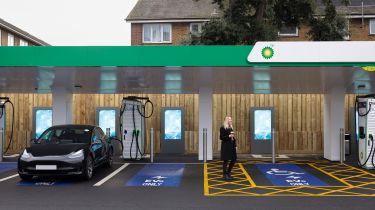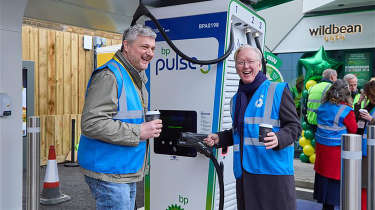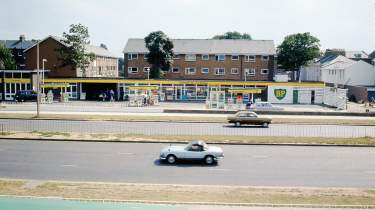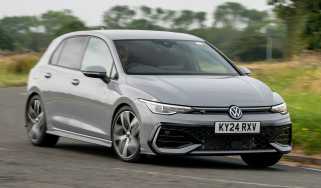Petrol station to EV charging station: is this the future of UK forecourts?
We visit a new BP forecourt charging hub that aims to revolutionise EV ownership
The first BP filling station forecourt to be transformed into an EV-only charging station has been launched in Hammersmith, west London, with the company citing declining pump sales and burgeoning demand for ultra-rapid charging on the A4/M4 corridor between the capital and Heathrow.
According to Richard Bartlett, BP Europe’s senior vice-president responsible for the BP Pulse charging network and its retail and convenience stores, the former fuel forecourt – which due to its high-traffic location has become one of London’s best-known since its opening in the Sixties – is already hitting charger utilisation rates that weren’t expected until 2030.
The new facility reflects BP’s focus on ultra-rapid charging sites, which is a change from the mindset in 2018, when the oil giant swallowed up Chargemaster’s UK network of 6,500 lower-powered public chargepoints at a cost of £130million. BP Pulse hopes its move towards hi-tech, ultra-rapid chargers on forecourts featuring well-appointed convenience facilities will make the reliability issues and low customer satisfaction levels associated with Chargemaster a thing of the past.
The new focus is based on BP’s understanding of consumer demand, says Bartlett, who suggests data from the existing BP Pulse network shows a declining appetite for slower chargers because electric car drivers simply don’t want to be tied to plugging-in overnight. They want ultra rapid top-ups instead.
“A lot of families are short of ultra-fast charging in the London market. So what we typically see here are cars such as the Audi or the Mercedes EVs, with great batteries that need very fast charging. You can be in
and out in 20 minutes.
“But when you’re here for 10, 15, 20 minutes – or sometimes longer depending on your car – what we also wanted to do was make sure there’s something you can do with the time,” he says, highlighting facilities such as wifi across the whole site, clean toilets, an M&S Food store and a coffee shop. Visitors can also take advantage of traditional filling station services such as air, screenwash and water, as well as pick up home deliveries or use digital parcel lockers.
According to Bartlett, business users and Uber drivers are also making good use of the site: “There are some amazing statistics now that one in three Uber miles in London are electric. They desperately need hubs like this to drive their business forward and reach their target to be 100 per cent electric in the next few years,” he says, adding that last year “the average Uber driver consumed enough power on BP Pulse’s network to power the average UK household for 24 months”.
Bartlett told Auto Express that the move to all-electric forecourts will be a gradual process, because BP will introduce its latest 300kW twin-bay ultra-rapid chargers alongside fuel pumps at many sites.
“This is the first of many evolving sites in the UK,” he says. “We are not going to convert all of our sites to hubs like this, but we’re going to convert several, and the reason for that is a lot of cars still need fuel. We’re going to combine fuel with EV with a great shop offer for the next decade. Then, as the car park transitions fully to electric, more of our sites will have this look and feel.”
However, even such a gradual transition could spell longer term trouble for operators of standalone charging hubs in less viable locations, and chargepoint operators with wider, but lower-powered, networks.
“I think, because the commercials don’t work for the owner or operator of the infrastructure, you’re going to end up with a lot of redundant slower-charging hardware,” says Bartlett, in answer to a question about the tendency of local authorities to invest taxpayer funds in slower on-street charging instead of focusing on ultra-rapid hubs.
“The easiest thing to do is just plug in a slow charger; you pop them up and can say ‘I’ve electrified my local borough council’. Which is all very well if I park overnight, and take the car in the morning.” But he points out that drivers on the busy A4 alongside the new BP charging location don’t use cars that way. “Most of the people driving on this road in front of us are time-constrained. They use their vehicle for business or pleasure, and they don’t want to do that.”
Bartlett also points to the competitive advantage BP has against more widely distributed networks, which he reckons will make its forecourts or hubs more competitive in the long run.
He explains: “It’s not inexpensive to maintain and operate these businesses. You’ve got to think of the construction cost, then the operating cost.” According to Bartlett, it costs the same to send a field service electrician out to a single hub (where they can manage all 10 bays) as it costs to send that same person to one of 10 chargers spread all over a borough.
“That’s 10 times more expensive than coming to a hub, so the ability for me to offer competitive pricing in the future is a function of scale and consolidation,” he claims. “You have different speeds for different needs, so there’s always a role for someone to have a slow charger. All I’m saying is we are not going to focus on that. The model doesn’t work for us.
“As BP we know what we want to do, we know what we like, we know we can make money, and we know what the customers we want to attract prefer.”
The fast charger rollout is now gathering pace
Valerio Ferro is general manager of BP Pulse UK. He told us that the company operates chargepoints in 225 fuel stations, and has plans to roll out approximately 500 new ultra-rapid chargers per year, which in many cases will replace lower-powered and sometimes unreliable older units.
Ferro says: “The focus is on the hub concept, because it’s what people want. We’ve done a lot of research, and people don’t want slow charging, especially those who are not able to charge at home or in the office – they’re looking for this kind of concept. So we exited home charging a couple of years ago, and now we’re focusing on ultra-rapid charging for people on the road.”
Buy a car with Auto Express. Our nationwide dealer network has some fantastic cars on offer right now with new, used and leasing deals to choose from...
Find a car with the experts







